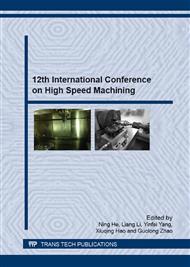[1]
G. Su, Z. Liu, L. Li, et al. Influences of chip serration on micro-topography of machined surface in high-speed cutting, J. International Journal of Machine Tools & Manufacture. 89(2015)202–207.
DOI: 10.1016/j.ijmachtools.2014.10.012
Google Scholar
[2]
T.R. Lin. Cutting behavior of a TiN-coated carbide drill with curved cutting edges during the high-speed machining of stainless steel, J. Journal of Materials Processing Technology. 127(1)(2002)8–16.
DOI: 10.1016/s0924-0136(02)00073-0
Google Scholar
[3]
X.J. Yang, K. Cao, W.H. Zhao, H. Liu and J. Zhang. An overall analysis of the influence of the servo control system on the frequency spectrum structure of the motor thrust, C. ASME 2012 International Mechanical Engineering Congress and Exposition. American Society of Mechanical Engineers. (2012).
DOI: 10.1115/imece2012-87020
Google Scholar
[4]
H. Liu. Dynamic Characteristic Analysis for Machine Tools Based on Concept of Generalized Manufacturing Space, J. Journal of Mechanical Engineering. 46(21) (2010)54-60.
DOI: 10.3901/jme.2010.21.054
Google Scholar
[5]
B.H. LU,W.H. Zhao,J. Zhang X.J. Yang, et al. Electromechanical Coupling in the Feed System with High Speed and High Acceleration, J. Journal of Mechanical Engineering. 49(6)(2013)2-11.
DOI: 10.3901/jme.2013.06.002
Google Scholar
[6]
W.H. Zhao, J. Zhang, H. Liu and X.J. Yang. New evaluation method on the precision of NC machine tools, J. Engineering Sciences. (1)(2013)93-98.
Google Scholar
[7]
K.Y. Lee, M.C. Kang, Y.H. Jeong, et al. Simulation of surface roughness and profile in high-speed end milling, J. Journal of Materials Processing Technology. 113(6)( 2001)410-415.
DOI: 10.1016/s0924-0136(01)00697-5
Google Scholar
[8]
B.H. Kim, C.N. Chu. Texture prediction of milled surfaces using texture superposition method, J. Computer-Aided Design. 31(8) (1999)485-494.
DOI: 10.1016/s0010-4485(99)00045-7
Google Scholar
[9]
Y. Mizugaki, M. Hao, K, Kikkawa, et al. Geometric Generating Mechanism of Machined Surface by Ball-nosed End Milling, J. CIRP Annals - Manufacturing Technology. 50(1) (2001)69–72.
DOI: 10.1016/s0007-8506(07)62073-3
Google Scholar
[10]
P. Koshy, R.C. Dewes, D.K. Aspinwall. High speed end milling of hardened AISI D2 tool steel (6558 HRC), J. Journal of Materials Processing Technology. 127(2) (2002)266–273.
DOI: 10.1016/s0924-0136(02)00155-3
Google Scholar
[11]
F. Ismail, E.G. Kubica. Active suppression of chatter in peripheral milling Part 1. A statistical indicator to evaluate the spindle speed modulation method, J. International Journal of Advanced Manufacturing Technology. 10(5) (1995)299-310.
DOI: 10.1007/bf01178983
Google Scholar
[12]
I.L. Wapnir, M. Fang, B . Zicherman, et al. A new on-line spindle speed regulation strategy for chatter control, J. International Journal of Machine Tools & Manufacture. 36(95) (1996) 651-660.
DOI: 10.1016/0890-6955(95)00076-3
Google Scholar
[13]
E. Soliman, F. Ismail. Chatter suppression by adaptive speed modulation, J. International Journal of Machine Tools & Manufacture. 37(3) (1997)355–369.
DOI: 10.1016/0890-6955(95)00084-4
Google Scholar
[14]
E. Al-Regib, J. Ni, S.H. Lee. Programming spindle speed variation for machine tool chatter suppression, J. International Journal of Machine Tools & Manufacture. 43(2003)1229-1240.
DOI: 10.1016/s0890-6955(03)00126-3
Google Scholar
[15]
A. Yilmaz, E. Al-Regib, J. Ni. Machine Tool Chatter Suppression by MultiLevel Random Spindle Speed Variation, J. Journal of Manufacturing Science & Engineering. 124(2) (2002) 208-216.
DOI: 10.1115/1.1378794
Google Scholar
[16]
N.S. Namachchivaya, Beddini R. Spindle Speed Variation for the Suppression of Regenerative Chatter, J. Journal of Nonlinear Science. 13(3)(2003)265-288.
DOI: 10.1007/s00332-003-0518-4
Google Scholar


